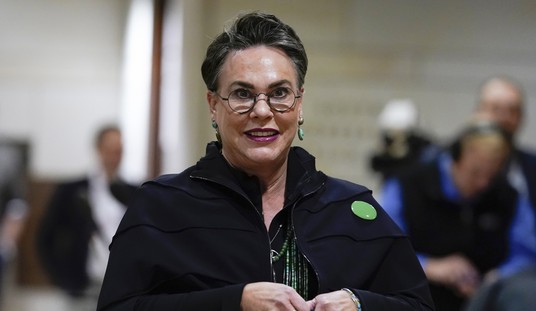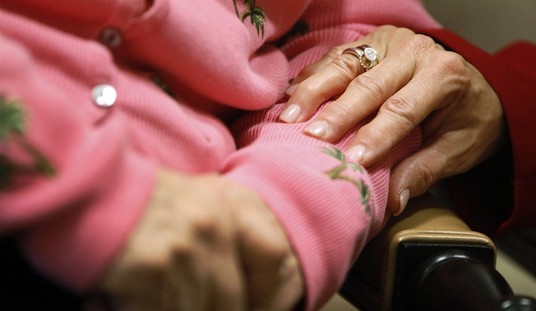As was reported on RedState yesterday by my colleague Nick Arama, Nancy Pelosi managed to drag enough bodies into the Capitol building to win a squeaker of a contest for Speaker of the House by a vote of 216 to 209.
Nick covered some of the machinations that were at work behind the scenes, and how it was a struggle for Pelosi to actually corral the votes she needed. Unlike votes on legislation, House rules require the physical presence of members for a vote to elect a new Speaker. The combination of certain members being reluctant Pelosi supporters — and a couple of outright opponents — along with questions about the health status and ability to travel regarding a couple of others (Rep. Alcee Hastings is battling pancreatic cancer and was unable to attend), left Pelosi with little margin for error in her 220 member majority.
I have written two articles in the recent past on the issue of whether Pelosi might face a meaningful challenge from within the Democrat Caucus for her position as Speaker.
Is Pelosi Vulnerable to a Challenge to Her Speakership?
Where Did Nancy Pelosi’s Votes For Her As Speaker Go?
The Democrats themselves and the punditocracy had proclaimed prior to the election that the Democrats would pick up somewhere between 10 and 15 seats on November 3. Exactly the opposite happened, with the Democrats losing many “purple” seats in districts that Joe Biden carried in the Presidential contest — which raises some questions about Biden’s vote totals in those districts, but that’s a different story.
Pelosi has also become an embarrassment — or she would be a national embarrassment if she was covered fairly and accurately by the media — for various gaffes made by her during the past two years, none more famous than her video interview during the pandemic “lockdown” where she assured everyone she had a sufficient supply of super-luxury high-end ice cream stocked away in her $10,000+ built-in side-by-side refrigerator/freezer.
She is also caught between the demands of the upstart avowed Marxists/socialists who have come into Congress riding the Democrat party movement following Socialist Bernie Sanders, and the electoral interests of more moderate members of her caucus who hail from red and purple districts where the party’s drift towards outright socialism likely costs them seats. In the immediate aftermath of the election on Nov. 3, those moderate members — after losing several races in such districts to GOP challengers — expressed their unhappiness with the Party’s embrace of the Marxist/socialist message coming from the far left. But socialists, led by AOC, openly called for a transition in leadership of the Party to the next generation.
I speculated in my earlier articles that Rep. Hakeen Jeffries from New York was positioning himself to challenge Pelosi for the Speaker’s Chair. Jeffries is the Chairman of the Democrat Caucus, which is the No. 4 position in the Democrat leadership. The two Representatives between him and Pelosi — Steny Hoyer and James Clyburn — are both from Pelosi’s generation of geriatric Democrat leaders, and if he’s was planning to try to make a move to challenge Pelosi, there’s no reason to think he would support Hoyer or Clyburn to take her place.
Part of this analysis focused on the fact that through the course of Pelosi’s tenure as Speaker there has always been an undercurrent of tension between her and her West Coast power base within the caucus, supported by her ability to raise massive amounts of money in California for the campaigns of other Democrat House members, and the New York/New England members of the Caucus. When she was first elected as Speaker when the Democrats recaptured the House in 2007, she supported John Murtha of Pennsylvania to be the House Majority Leader, the No. 2 leadership position. Murtha was a powerful Committee Chairman that Pelosi was attempting to move into party leadership. Normally a representative pursues one path or the other, and supporting Murtha was a break with protocol. Murtha was challenged — meaning Pelosi was challenged — by Steny Hoyer who was the House Minority Whip, and would have been next in line to be Majority Leader in the normal process. The Democrats voted for Hoyer by a margin of 149-86, a stunning slap in the fact to Pelosi as new Speaker. The vote pretty much lined up Northeast + Mid-Atlantic + Midwest Democrats v. West Coast + Pacific Northwest + Southern Democrats.
Some of the tension between the two groups have played out in internal fights over Committee chairs — none more famous in my opinion than the fight over the Chair of the House Judiciary Committee. When the Democrats retook the House in the Nov. 2018 midterms, California Rep. Zoe Lofgren made public the fact that she wanted the Judiciary Committee Chair. But longtime Democrat simpleton Jerrod Nadler was ahead of her in seniority and was next in line for the Chair after waiting behind slightly dumber John Conyers who had been the senior Democrat on the Committee when the Democrats were last in the majority. Lofgren is a longtime solid Pelosi lieutenant from Northern California, and Pelosi wanted her to have the seat. While she’s not a sterling legal mind herself, Lofgren is near “Solomonesque” when compared to the braindead Nadler. The NY/NE staked out the ground as worth fighting over to preserve their leadership positions within the party, and Pelosi had to back down and give the Committee to Nadler even though everyone knew what would happen. That’s is the reason behind another Pelosi loyalist, Adam Schiff, as Chairman of the Intelligence Committee was tasked to lead the impeachment investigation in 2019 rather than the Judiciary Committee.
With that history, I’m sure some readers are wondering “Hey SWC — What’s your point?”
My point is this — John Boehner thought he had survived the crocodiles at his feet when he was re-elected to his third term as Speaker in Jan. 2015. Nine months later he announced his resignation as Speaker and an intention to resign from Congress effective October 31, 2015. Tensions in the GOP caucus that existed from the time he became Speaker were never resolved and were exacerbated by differences of opinion on how to deal with the Obama Administration in negotiations over continued funding of the government. Conservative members of the caucus — including many elected during the “Tea Party” election of 2010 — mounted a challenge to his leadership behind closed doors, and it became clear he would lose a caucus vote if one was taken.
The fact that Pelosi garnered 216 votes yesterday does not mean there are no real challenges to her leadership behind closed doors within the caucus. The true test is whether there will continue to be 111 Democrats who support her as Speaker if given another option. Because that she has announced that this will be her final term as Speaker — and maybe her final term in the House — any challengers may opt to simply let her ride out her two years to retirement.
One fact that supports that view is the very real likelihood that the Democrats will lose the majority in the House in 2022. If that happens, the finger of blame can be pointed in Pelosi’s direction. If Jeffries or someone else were to challenge her now and win, the bag of canine excrement that might follow the 2022 midterms will end up being held by whoever was Speaker on the day those elections take place.
But Pelosi can no longer keep the troops in line with the power from the sheer numbers of the California delegation, and the vast amounts of funds she could raise on behalf of other members who bought for her their loyalty. She is more vulnerable as Speaker than she has ever been before. The question is whether any other Democrat really wants that job right now.















Join the conversation as a VIP Member